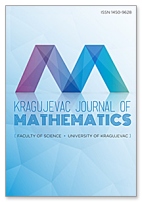L^{∞}-Asymptotic Behavior of a Finite Element Method for a System of Parabolic Quasi-Variational Inequalities with Nonlinear Source Terms
 Download PDF
Download PDF
Authors: D. C. BENCHETTAH
DOI: 10.46793/KgJMat2303.347B
Abstract:
This paper is an extension and a generalization of the previous results, cf. [?, ?, ?, ?]. It is devoted to studying the finite element approximation of the non coercive system of parabolic quasi-variational inequalities related to the management of energy production problem. Specifically, we prove optimal L∞-asymptotic behavior of the system of evolutionary quasi-variational inequalities with nonlinear source terms using the finite element spatial approximation and the subsolutions method.
Keywords:
Quasi-variational inequalities, asymptotic behavior, subsolutions method, finite elements approximation, L∞-error estimate.
References:
[1] C. Baiocchi, Estimation d’erreur dans L∞ pour les inequations a obstacle, Mathematical Aspects of Finite Methods 606 (1977), 27–34. https://doi.org/10.1007/BFb0064453
[2] D. C. Benchettah and M. Haiour, L∞-asymptotic behavior of the variational inequality related to American options problem, Applied Mathematics 5(8) (2014), 1299–1309. https://doi.org/10.4236/am.2014.58122
[3] D. C. Benchettah and M. Haiour, Sub-solution approach for the asymptotic behavior of a parabolic variational inequality related to American options problem, Global Journal of Pure and Applied Mathematics, 11(4) (2015), 1727–1745.
[4] A. Bensoussan and J. L. Lions, Impulse Control and Quasi-Variational Inequalities, Gauthier Villars, Paris, 1984.
[5] A. Bensoussan and J. L. Lions, Applications des inèquations
variationnelles en contr le stochastique, Dunod, Paris, 1978.
le stochastique, Dunod, Paris, 1978.
[6] M. A. Bencheikh le Hocine, S. Boulaaras and M. Haiour, An optimal L∞-error estimate for an approximation of a parabolic variational inequality, Numer. Funct. Anal. Optim. 37(1) (2015), 1–18. https://doi.org/10.1080/01630563.2015.1109520
[7] M. A. Bencheikh le Hocine, S. Boulaaras and M. Haiour, On finite element approximation of system of parabolic quasi-variationnal inequalities related to stochastic control problems, Cogent Math. 3(1) (2016), Paper ID 1251386. https://doi.org/10.1080/23311835.2016.1251386
[8] S. Boulaaras and M. Haiour, The finite element approximation of evolutionary Hamilton-Jacobi-Bellman equations with nonlinear source terms, Indag. Math. 24(1) (2013), 161–173. https://doi.org/10.1016/j.indag.2012.07.005
[9] S. Boulaaras and M. Haiour, The theta time scheme combined with a finite-element spatial approximation in the evolutionary Hamilton-Jacobi-Bellman equation with linear source terms, Comput. Math. Model. 25(3) (2014), 423–438.
[10] S. Boulaaras and M. Haiour, L∞-asymptotic behavior for a finite element approximation in parabolic quasi-variational inequalities related to impulse control problem, Appl. Math. Comput. 217(14) (2011), 6443–6450. https://doi.org/10.1016/j.amc.2011.01.025
[11] S. Boulaaras, M. A. Bencheikh le Hocine and M. Haiour, The finite element approximation in a system of parabolic quasi-variationnal inequalities related to management of energy production with mixed boundary condition, Comput. Math. Model. 25(4) (2014), 530–543.
[12] M. Boulbrachene, Pointwise error estimates for a class of elliptic quasi-variational inequalities with nonlinear source terms, Appl. Math. Comput. 161(1) (2005), 129–138.
[13] M. Boulbrachene, On the finite element approximation of variational inequalities with noncoercive operators, Numer. Funct. Anal. Optim. 36(9) (2015), 1107–1121. https://doi.org/10.1080/01630563.2015.1056913
[14] M. Boulbrachene and P. Cortey Dumont, Optimal L∞-error estimate of a finite element method for Hamilton Jacobi Bellman equations, Numer. Funct. Anal. Optim. 30(5–6) (2009), 421–435. https://doi.org/10.1080/01630560902987683
[15] M. Boulbrachene, On the finite element approximation of variational inequalities with noncoercive operators, Numer. Funct. Anal. Optim. 36(9) (2015), 1107–1121.
[16] M. Boulbrachene, Pointwise error estimate for a noncoercive system of quasi-variational inequalities related to the management of energy production, Journal of Inequalities in Pure and Applied Mathematics 3(5) (2002), Article ID 79.
[17] M. Boulbrachene, On variational inequalities with vanishing zero term, J. Inequal. Appl. (2013), Article ID 438. https://doi.org/10.1186/1029-242X-2013-438
[18] F. Brezzi and L. A. Caffarelli, Convergence of the discrete free boundaries for finite element approximations, RAIRO Analyse Numérique 17(4) (1983), 385–395.
[19] P. G. Ciarlet and P. A. Raviart, Maximum principle and uniform convergence for the finite element method, Comput. Methods Appl. Mech. Engrg. 2(1) (1973), 17–31.
[20] P. Cortey-Dumont, Sur l’analyse numérique des équations de Hamilton-Jacobi-Bellman, Math. Methods Appl. Sci. 9(1) (1987), 198–209. https://doi.org/10.1002/mma.1670090115
[21] P. Cortey-Dumont, Sur les inéquations variationnelles à opérateurs non coercif, Modélisation mathématique et analyse numérique 19(2) (1985), 195–212.
[22] J. Hannouzet and P. Joly, Convergence uniforme des iteres definissant la solution d’une inéquation quasi-variationnelle, C. R. Math. Acad. Sci. Paris, Serie A 286 (1978), 1 page. https://10.5802/jedp.172
[23] J. Nitsche, L∞-convergence of finite element approximations, mathematical aspects of finite element methods, Lecture Notes in Math. 606 (1977), 261–274.
[24] R. H. Nochetto, A note on the approximation of free boundaries by finite element methods, Modelisation Mathématique et Analyse Numérique 20(2) (1986), 355–368.
[25] B. Perthame, Some remarks on quasi-variational inequalities and the associated impulsive control problem, Ann. Inst. H. Poincaré Anal. Non Linéaire 2(3) (1985), 237–260.
[26] A. Quarteroni and A. Valli, Numerical Approximation of Partial Differential Equations, Springer, Berlin, Heidelberg, 1994.
